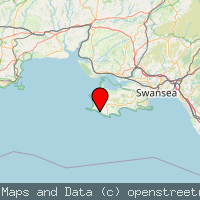Paviland Cave
Also known as Goat's Hole
Excavation
J. Traherne et al., 1822-23; O.R. Vivian, 1909; W.J. Sollas, 1912; D. Garrod, 1926; J.G. Rutter, 1943; S. Aldhouse-Green, 1997.
Curation
University Museum, Oxford; Ashmolean Museum, Oxford; Natural History Museum, London; Swansea Museum; National Museum of Wales, Cardiff; Bolton Museum; Manchester Museum.
Burials
MNI: 3
Finds
Flint and chert artefacts, worked bone and ivory, animal bones.
Dates
| Period | Reliability |
|---|---|
| Upper Palaeolithic | 14C date obtained directly on human remains |
| Mesolithic | 14C date obtained directly on human remains |
14C
28,870 bp (OxA-16412), 19,490 bp (OxA-16413), 28,400 (OxA-16502), 28,820 bp (OxA-16503) on human bone (Paviland 1); 7190 bp (OxA-681) on human bone (Paviland 2).
External References
| Royal Commission CARN Database | 300251 |
| Sites and Monument Record | 00118W |
| Scheduled Ancient Monuments | Gm 504 |
| Cambrian Caving Council Record | 1093 |
Bibliography
Aldhouse-Green, S. & Pettitt, P. (1998) Paviland Cave: contextualising the ‘Red Lady’. Antiquity 72: 756-772.
Aldhouse-Green, S.H.R., ed. (2000) Paviland Cave and the ‘Red Lady’: a definitive report. Western Academic and Specialist Press, Bristol.
Bowen, D.Q. (1970) The palaeoenvironment of the ‘Red Lady’ of Paviland. Antiquity 44: 134-136.
Buckland, W. (1823) Reliquiae Diluvianae. Murray, London.
Gowlett, J.A.J. et al. (1986) Radiocarbon dates from the Oxford AMS system: Archaeometry Datelist 4. Archaeometry 28 (2): 206-221.
Green, H.S. & Walker, E. (1991) Ice Age Hunters. Neanderthals and Early Modern Hunters in Wales. National Museum of Wales, Cardiff.
Hedges, R.E.M. et al. (1989) Radiocarbon dates from the Oxford AMS system: Archaeometry Datelist 9. Archaeometry 31 (2): 207-234.
Jacobi, R.M. (1980) The Upper Palaeolithic of Britain with special reference to Wales. In Taylor, J.A. (ed.) Culture and Environment in Prehistoric Wales. British Archaeological Reports British Series 76: 15-100.
Jacobi, R.M. and Higham, T.F.G. (2008) The ‘‘Red Lady’’ ages gracefully: new ultrafiltration AMS determinations from Paviland. Journal of Human Evolution 55: 898-907.
John, B.S. (1971) The ‘Red Lady’ of Paviland, a comment. Antiquity 45: 141-144.
McComb, P. (1989) Upper Palaeolithic Artefacts from Britain and Belgium. An Inventory and Technological Description. British Archaeological Reports International Series 481.
Molleson, T. (1976) Remains of Pleistocene man in Paviland and Pontnewydd Caves. Transactions of the British Cave Research Association 3: 112-116.
Molleson, T. & Burleigh, R. (1978) A new date for Goat’s Hole Cave. Antiquity 52: 143-145.
Oakley, K.P. (1968) The date of the ‘red lady’ of Paviland. Antiquity 42: 306-307.
Oakley, K.P. (1971) Radiocarbon dating of the Proto-Solutrean in Wales. Nature 231: 112.
Oakley, K.P. (1980) Relative dating of the fossil hominids of Europe. Bulletin of the British Museum (Natural History). Geology Series 34: 1-63.
Rutter, J.G. & Allen, E.E. (1948) The Gower Caves. Welsh Guides, Swansea.
Sollas, W.J. (1913) Paviland Cave: an Aurignacian station in Wales. Journal of the Royal Anthropological Institute 43: 325-374.
Stringer, C.B. (1986) Direct dates for the fossil hominid record. In Gowlett, J.A.J. & Hedges, R.E.M. (eds) Archaeological Results from Accelerator Dating. Oxford Committee for Archaeology Monograph 11. Oxford University, Oxford, pp. 45-50.
Article Author Graham Mullan

